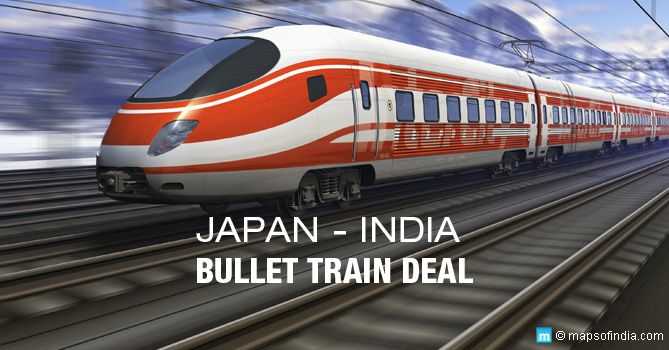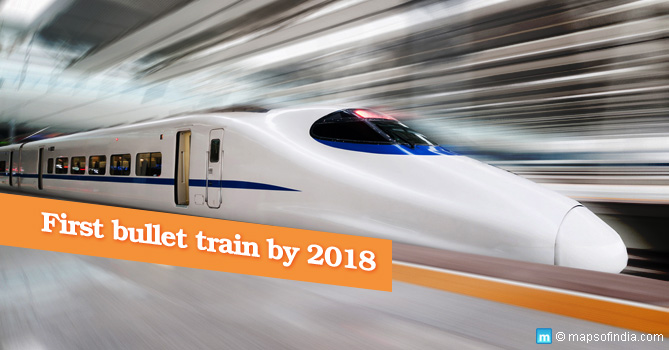India broke new ground when it signed the Rs 98,000 crore deal with Japan to build the 505 km High Speed Rail System connecting Ahmedabad with Mumbai. The train is expected to travel at 320 km per hour and is expected to reduce travel time from existing eight hours to less than two hours. The train will start from Bandra-Kurla Complex and will have 11 stations on its route. The project will entail construction of 11 tunnels, including one tunnel that will run under the sea near Mumbai.
Deal strengthens Indo-Japan relationship
PM Modi has been focusing on strengthening India-Japan relations by deepening economic and strategic ties. The High Speed Rail System deal was signed this week during Japanese Prime Minister Shinzo Abe’s visit to India and involves transfer of technology, joint research and manufacturing. The project is likely to trigger several other manufacturing projects under the Make in India initiative.
Abe’s visit is path breaking, as India has finally signed the agreement for transfer of civilian nuclear technology with Japan, which has come after years of Japanese hesitation to export civilian nuclear technology to India.
Japan also signed a key deal on defence cooperation which covers transfer of military technology, sale of military hardware, sharing of classified military information and possible joint defence research in future. India will also extend naval cooperation with Japan that will further strengthen India-Japan strategic partnership.
How Japan swung the deal?
Japan has been pushing to export its high speed train technology overseas but has met with little success. In recent years, China has been aggressive in its effort to export its high speed train systems, in direct competition with Japan.
In September this year, Japan lost a $5 billion opportunity to build a 140 km high speed train corridor connecting Jakarta with Bandung in Indonesia. Despite the Japanese investing several years conducting feasibility studies and related work on the project, the final contract was awarded to the Chinese. China offered to finance and build the project with no financial contribution from the Indonesian government and therefore, no financial guarantee was required from the government. This was apparently the main reason why Japan lost the contract.
Taking no chances, Japan was keen to win the Ahmedabad – Mumbai high speed train project and thus offered very attractive terms that included funding the project up to 81% of the project cost, with a very low interest component of 0.3%, payment period extending to 40 years, and with no payment to be made for the first 10 years. These terms were far more attractive than what the Chinese have offered and were the main factor, besides its unblemished record on safety that swung the contract in Japan’s favour.
Japan is rapidly emerging as India’s key development partner in financing several large infrastructure projects, including rail projects like the Rs 4,410 crore Ahmedabad Metro project and the Rs 1,069 crore Chennai Metro Rail project.
The Ahmedabad-Mumbai high speed train project will certainly boost manufacturing in India and offer opportunity to the Indian Railways to upgrade its overall technical, operational and maintenance skills. If this project is implemented successfully, it will act as a catalyst to the development of high speed rail network in India, just the way Delhi Metro triggered the demand for metro rail in other cities.
China is already conducting feasibility studies for the 2,200 km high speed train corridor that will connect Delhi to Chennai and the 1,200 km corridor connecting Delhi with Mumbai. China is aggressively pushing for these projects and it remains to be seen how it responds to competition from Japan while bidding for these contracts.
Is the Rs 98,000 crore investment justified?
There is a counter narrative to India’s decision to invest Rs 98,000 crore on a single high speed train corridor. Let’s examine this viewpoint.
The objective of the project is to reduce train travel time between Ahmedabad and Mumbai from the current eight hours to two hours. The Shinkansen trains in Japan carry between 1300 and 1600 passengers in each train. That is equal to what 7 Airbus 320 neo aircraft can carry – 1600 train passengers / 240 plane passengers = 7 aircraft (240 passengers per Airbus 320 neo).
The listed cost of an Airbus 320 neo is Rs 700 crore approx ($106.2 million), add a generous Rs 100 crore towards support infrastructure i.e. Rs 800 crore x 7 aircraft = Rs 5,600 crore. The air travel time between Mumbai-Ahmedabad is 75 mins.
From the above, we can see that 1600 passengers can travel by air in lesser time than by train. Now compare the costs. Rs 5,600 crore vs Rs 98,000 crore to achieve the same purpose! The saving is a whopping Rs 92,000 crore that can be invested in modernization of the existing train tracks, investing in newer coaches and wagons, improving signaling equipment and improving passenger services at stations.
Now the cost to passenger. The current airfares are between 2,200 and Rs 2,600 one way on the Mumbai-Ahmedabad route. This can come down further with competition and increased frequency. The high speed train fare in China (for comparative reference) on the Beijing-Shanghai route is Rs 5,346 – $81(2nd class) and Rs 9,108 – $138 (1st class). Therefore, one can expect the train fare in India to far exceed the current airfare rates. Remember, the original objective is to transfer 1600 passengers within 2 hours between the two stated cities.
So, can India really indulge in this massive investment on one project for achieving an objective that can be easily achieved at a fraction of the cost by simply adding more aircraft?
Explore More :
What does PM Modi’s Japan visit mean for India?
Railways introduces ‘surge pricing’ in Rajdhani, Duronto and Shatabdi trains
Talgo High Speed Train Trial Run in India
India to get its first bullet train in 2018
High Speed Trains – Challenging Questions Popping Up
Delhi Metro’s First Driverless Train
The Maharajas’ Express – Luxury Train in India
Semi High Speed Rail Corridors in India
Royal Orient Express Luxury Train Route Map
Gatimaan Express Route map : Fastest Train in India
E-Catering Food Services Launched by IRCTC





